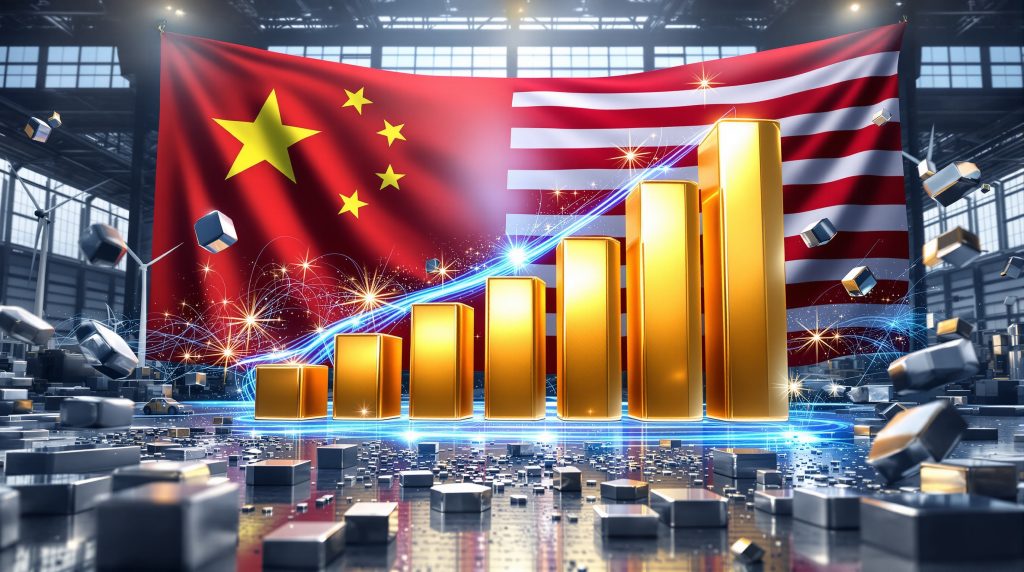Understanding the Current Export Landscape
China rare earth magnet exports to US have become a critical focal point in understanding global supply chain vulnerabilities and strategic resource dependencies. Rare earth permanent magnets represent one of the most strategically important materials in modern technology, serving as essential components in applications ranging from electric vehicle motors to wind turbines and advanced defense systems. These magnets, primarily composed of neodymium, dysprosium, praseodymium, and terbium, offer magnetic field strengths exceeding 1.4 Tesla, making them indispensable for high-performance applications requiring compact, powerful magnetic solutions.
China's dominance in this sector remains virtually unchallenged, controlling approximately 90% of global rare earth processing capacity despite holding only about 35% of known global reserves. This processing monopoly stems from decades of investment in separation and purification technologies, combined with integrated supply chains that connect mining operations directly to magnet manufacturing facilities. The technical complexity of rare earth processing, requiring 10-15 specialised steps including hydrometallurgical extraction and solvent extraction, creates significant barriers for competitors seeking to establish alternative supply chains.
The strategic importance of these materials becomes evident when examining their applications across critical sectors. Electric vehicle manufacturers typically require 1-2 kilograms of rare earth permanent magnets per vehicle, while a single 3-megawatt offshore wind turbine demands approximately 600 kilograms. Defense applications prove even more intensive, with F-35 fighter jets containing approximately 417 kilograms of rare earth materials and Virginia-class submarines requiring roughly 4,200 kilograms for propulsion and weapons systems.
Recent trade data reveals the United States accounted for 7.3% of China's total rare earth magnet exports by volume in September 2025, positioning it as the fourth-largest recipient behind Germany, South Korea, and Vietnam. This relatively modest share masks the critical nature of Chinese supplies for American manufacturers, who import approximately 80-85% of their rare earth magnet requirements from Chinese suppliers.
What Caused the Dramatic Export Fluctuations in 2025?
The volatile pattern of China rare earth magnet exports to US throughout 2025 reflects the intersection of trade policy disputes and strategic resource management. Export data shows significant month-to-month variations, with September 2025 recording 420.5 tonnes of shipments, representing a 28.7% decline from August levels and a 29.5% year-over-year decrease.
These fluctuations cannot be understood without examining the broader context of export control policies implemented by Chinese authorities. In June 2025, Beijing agreed to expedite rare earth export permit processing during bilateral negotiations held in London, temporarily alleviating supply constraints that had developed earlier in the year. However, this diplomatic breakthrough provided temporary relief for American manufacturers who had experienced production delays due to supply shortages.
The permit expediting agreement emerged from recognition by both sides that supply chain disruptions were impacting broader economic relationships. Chinese authorities maintained their licensing requirements while streamlining the approval process, allowing for more predictable supply flows while preserving Beijing's policy flexibility. This approach demonstrates how administrative mechanisms can serve as tools for managing trade relationships without requiring formal policy reversals.
However, the recovery proved temporary, with export volumes declining in subsequent months despite the enhanced permit processing arrangements. The year-over-year comparison shows August 2025 exports down 11.9% compared to the previous year, followed by the more pronounced 29.5% decline in September. This pattern suggests that underlying trade tensions continued to influence commercial relationships even after diplomatic interventions.
The timing and scale of these fluctuations align with China's broader strategy of utilising critical mineral supply chains as leverage in trade negotiations. Furthermore, the recent critical minerals order demonstrates how administrative mechanisms can serve as strategic tools. Export control implementation reflects Beijing's recognition that its processing dominance provides significant negotiating power, particularly given the multi-year timelines required for Western nations to establish alternative supply sources.
How Do Recent Export Controls Affect US-China Trade Relations?
The implementation of export controls on rare earth magnets illustrates how critical materials have become central elements in US-China trade relations. Data from China's General Administration of Customs reveals the direct impact of these policies on bilateral trade flows, with American importers experiencing significant supply volatility throughout 2025.
| Month | Export Volume (Tonnes) | Monthly Change | Annual Change | US Ranking |
|---|---|---|---|---|
| August 2025 | 589.5* | – | -11.9% | 2nd |
| September 2025 | 420.5 | -28.7% | -29.5% | 4th |
*Estimated based on September data and reported percentage changes
The shift in the United States' ranking from second-largest recipient in August to fourth-largest in September demonstrates how quickly trade patterns can change under policy pressure. Germany, South Korea, and Vietnam have maintained or expanded their positions as primary destinations for Chinese rare earth magnet exports, suggesting that Chinese suppliers have successfully diversified their customer base to reduce dependence on American markets.
This diversification strategy serves dual purposes for Chinese exporters. First, it provides commercial flexibility by reducing exposure to policy-driven demand fluctuations from any single market. Second, it demonstrates to American negotiators that export restrictions can be implemented without severely damaging Chinese commercial interests, potentially strengthening Beijing's position in future trade discussions.
The 7.3% share of total Chinese exports that American importers represented in September 2025 reflects this strategic rebalancing. While the United States remains an important market for rare earth magnets, its relative significance has diminished as Chinese exporters have cultivated relationships with manufacturers in Europe and Asia. This shift particularly benefits German automotive manufacturers transitioning to electric vehicle production and South Korean electronics companies requiring high-performance magnets for consumer devices.
Policy implementation has followed established patterns from China's export control framework, which eliminates quotas while maintaining administrative oversight through licensing requirements. This approach complies with World Trade Organization rulings that previously challenged China's quota-based restrictions while preserving government authority to manage exports based on national security considerations. However, US‑China trade impacts continue to shape commercial relationships across multiple sectors.
Which Industries Face the Greatest Supply Chain Risks?
Electric vehicle manufacturing represents the sector most vulnerable to rare earth magnet supply disruptions, given the critical role these materials play in traction motor performance. Modern EV motors require magnets with energy products exceeding 35 MGOe to achieve necessary power density within compact designs, making substitution with alternative materials extremely challenging without significant performance compromises.
The global EV market's projected growth amplifies these vulnerabilities, with annual production reaching 13.6 million units in 2023 and requiring approximately 13,600-27,200 metric tons of rare earth magnets. Industry projections estimate this demand will expand to 100,000 tonnes annually by 2030, creating unprecedented pressure on supply chains already strained by geopolitical tensions.
Key EV supply chain vulnerabilities include:
- Motor efficiency requirements: NdFeB magnets are essential for achieving the torque density needed in compact EV drivetrains
- Temperature performance: Electric motors operating in automotive environments require magnets maintaining stability at temperatures up to 200°C
- Cost sensitivity: Rare earth content represents 15-20% of total motor manufacturing costs, making supply disruptions economically significant
- Production scaling: Automotive manufacturers operate on multi-year production planning cycles, making supply flexibility critical
Defence and aerospace sectors face even more acute risks due to performance requirements that eliminate most substitution options. Virginia-class submarines require approximately 4,200 kilograms of rare earth permanent magnets for propulsion and weapons systems, while F-35 fighter jets depend on these materials for radar systems, communications equipment, and flight controls. The specialised nature of military applications means that performance compromises are generally unacceptable, creating absolute dependencies on high-grade rare earth magnets.
Wind energy infrastructure development confronts similar challenges, particularly for direct-drive turbines that eliminate gearboxes by using permanent magnet generators. These systems, representing approximately 28% of new wind installations globally, require magnets with coercivity above 12 kOe for corrosion resistance in offshore environments. A single 3-megawatt offshore turbine typically contains 600 kilograms of rare earth magnets, making large-scale renewable energy deployment sensitive to supply chain stability.
The Department of Defence has identified rare earth permanent magnets as critical materials with supply chain vulnerabilities that could impact national security if disruptions occur during periods of increased military production requirements.
Consumer electronics manufacturing, while using smaller quantities per unit, faces risks due to production volumes. Global smartphone production of approximately 1.2 billion units annually requires an estimated 2,000-3,000 metric tons of rare earth magnets for speakers, vibration motors, and cameras. The consumer electronics sector's sensitivity to cost fluctuations makes supply price volatility particularly problematic for maintaining competitive market positions.
What Are the Key Market Dynamics Shaping Future Trade?
Market dynamics in rare earth magnet trade reflect the intersection of technological demand growth, geopolitical tensions, and supply chain concentration risks. The global market, valued at approximately $18.4 billion in 2023, faces projected expansion to $32.5 billion by 2030, representing an 8.3% compound annual growth rate driven primarily by electric vehicle and renewable energy adoption.
Price volatility remains a defining characteristic of rare earth markets, with historical examples demonstrating extreme fluctuation potential. During 2021 supply concerns, neodymium oxide prices increased 47% from $46/kg to $68/kg within eight months, while dysprosium oxide experienced a 92% price surge from $256/kg to $492/kg. These fluctuations reflect the market's sensitivity to supply disruptions and the limited availability of substitute materials.
Export destination patterns reveal strategic shifts in Chinese trade relationships:
- Germany: Leading recipient position reflects European automotive industry's transition to electric vehicle production
- South Korea: Strong demand from electronics manufacturers and growing EV production capabilities
- Vietnam: Emerging importance due to electronics manufacturing outsourcing and supply chain diversification strategies
- United States: Declining relative position despite absolute demand growth, reflecting trade policy impacts
Inventory management strategies have evolved in response to supply volatility, with American manufacturers typically maintaining 3-6 months of rare earth magnet inventory to buffer against disruptions. This approach increases working capital requirements but provides operational flexibility during supply constraints. However, inventory strategies face limitations when disruptions extend beyond typical buffer periods or when rapid demand growth exhausts stockpiled materials.
Long-term supply agreements have become increasingly important for major consumers seeking to secure reliable access to rare earth magnets. These contracts often include price stabilisation mechanisms, minimum supply guarantees, and force majeure provisions addressing geopolitical disruptions. However, the concentration of processing capacity in China limits the effectiveness of such agreements when broader policy restrictions are implemented.
Market psychology plays a significant role in price formation, with supply concerns often triggering speculative buying that amplifies underlying supply-demand imbalances. According to recent analysis from the Center for Strategic and International Studies, the 2010 experience, when China temporarily halted rare earth exports to Japan and prices increased 300-700% within months, demonstrates how quickly market sentiment can shift during geopolitical crises. Furthermore, as reported by Reuters, recent export data confirms continued volatility in trade patterns.
How Are Western Nations Responding to Supply Chain Vulnerabilities?
Western nations have launched comprehensive initiatives to address rare earth supply chain vulnerabilities, though progress faces significant technical and economic challenges. The United States has prioritised domestic production capabilities, with Mountain Pass mine in California representing the only active American rare earth mining operation, producing approximately 43,000 metric tons of concentrate in 2023.
Processing capabilities represent the most critical bottleneck in Western supply chain development. MP Materials has begun construction of a rare earth magnet manufacturing facility in Texas, projected for completion in 2025 with annual capacity of 1,000 tonnes. However, this capacity represents less than 1% of global demand, illustrating the scale of investment required to achieve meaningful supply diversification.
The European Union's response centres on the Critical Raw Materials Act adopted in 2024, which establishes ambitious targets for supply chain independence. Moreover, the development of a new European CRM facility represents a significant step towards reducing dependency on Chinese processing capabilities:
- Domestic production of at least 10% of annual rare earth consumption by 2030
- Processing of at least 40% of annual consumption within EU member states by 2030
- Strategic stockpiling programmes for critical periods when supply disruptions occur
- Investment incentives for private sector development of processing capabilities
Australian development projects offer the most promising near-term alternatives to Chinese processing dominance. Lynas Rare Earths operates Mount Weld mine and Malaysian processing facilities, producing approximately 10,500 tonnes of rare earth oxides in fiscal year 2023. The company's planned Kalgoorlie processing facility, estimated for completion in 2026, would establish Australian processing independence for its domestic production. This aligns with the broader Australian strategic reserve initiative.
Canadian initiatives under the Critical Minerals Strategy include resource development and processing investment incentives, though projects like Saskatchewan's Nechalacho rare earth development have faced delays due to environmental approvals and financing challenges. The complexity of rare earth ore processing, requiring $500 million to $1 billion in capital investment and 5-7 years for construction, limits the speed at which alternative capacity can be developed.
Technical expertise represents an often-overlooked constraint in supply chain diversification efforts. Chinese companies have accumulated decades of process optimisation knowledge for efficient rare earth separation and purification. Western companies attempting to establish comparable capabilities face learning curves that extend development timelines and increase operational risks during initial production phases.
International cooperation frameworks, including the Quad nations partnership between the United States, Australia, Japan, and India, have identified rare earth supply chain cooperation as priority areas. However, translating diplomatic agreements into commercial projects requires overcoming regulatory differences, financing arrangements, and technology transfer mechanisms that remain under development.
What Do Export Trends Reveal About Future US-China Relations?
Export trend analysis reveals how rare earth magnets have become instruments of economic statecraft in US-China relations, with supply flows reflecting broader diplomatic dynamics. The pattern of restrictions followed by partial recovery demonstrates both nations' recognition that complete supply disruption would damage their respective economic interests while maintaining policy leverage for future negotiations.
The June 2025 London agreement that expedited permit processing illustrates how technical administrative arrangements can provide temporary solutions to trade disputes without requiring fundamental policy changes. This approach allows both sides to claim policy victories while maintaining flexibility for future adjustments based on evolving political relationships.
However, the subsequent decline in exports during August and September 2025, despite the permit agreement, suggests that underlying structural tensions continue to influence commercial relationships. The 29.5% year-over-year decline in September shipments indicates that policy uncertainty has created lasting changes in supply chain relationships, with American importers likely pursuing alternative sources to reduce dependency risks.
China's strategic approach reflects lessons learned from the 2010 rare earth export restrictions against Japan, which triggered successful World Trade Organization challenges and accelerated international diversification efforts. Current policies appear designed to maintain pressure on American importers while avoiding actions that could be characterised as complete export bans under international trade law.
The timing of export fluctuations relative to broader trade negotiations suggests coordination between rare earth policies and other elements of US-China economic relations. Export controls serve as bargaining chips that can be adjusted based on progress in areas such as technology transfer restrictions, tariff policies, and investment limitations affecting Chinese companies operating in American markets.
Market positioning changes reveal strategic implications beyond immediate commercial impacts. The United States' decline from second to fourth-largest recipient of China rare earth magnet exports to US demonstrates how quickly trade relationships can be restructured when alternative markets are available. This flexibility strengthens China's negotiating position by reducing dependency on American demand while maintaining the capability to restore supply flows when diplomatic progress occurs.
Future relationship patterns will likely depend on several key factors:
- Alternative supply development: Progress in Western processing capabilities will reduce China's leverage over time
- Technology advancement: Breakthrough developments in rare-earth-free alternatives could fundamentally alter market dynamics
- Geopolitical stability: Broader US-China relations will continue influencing specific trade sector policies
- Economic interdependence: Mutual interests in maintaining some level of commercial cooperation despite political tensions
Which Factors Will Determine Long-Term Supply Security?
Technology development represents the most promising pathway for reducing rare earth magnet supply vulnerabilities, with multiple research directions showing potential for significant impact. Recycling technologies offer near-term opportunities, as approximately 15-25% of rare earth permanent magnets could theoretically be recovered from end-of-life products, though current recycling rates remain below 1% globally.
Advanced recycling methods demonstrate impressive technical capabilities:
- Direct reuse processes: Demagnetising, crushing, and reprocessing can recover 95-98% of rare earth content from used magnets
- Chemical extraction: Hydrometallurgical processes can separate individual rare earth elements, though energy costs limit economic viability
- Grain boundary diffusion: New techniques have reduced dysprosium content in magnets by 20-30% while maintaining performance specifications
- Urban mining potential: The Department of Energy estimates recycling could supply 10-15% of US rare earth demand by 2035 if scaled effectively
Alternative material research has received substantial investment, with the Department of Energy's ARPA-E programme funding over 30 projects researching rare-earth-free permanent magnets since 2016, totalling more than $100 million in funding. Manganese-based L1₀-MnAl magnets have achieved energy products up to 10 MGOe, approximately 20-30% of NdFeB magnet strength, making them suitable for lower-performance applications.
Iron-nitride compounds show theoretical potential for matching or exceeding rare earth magnet performance, though commercial production methods remain under development. These materials could revolutionise permanent magnet markets if manufacturing challenges can be resolved, potentially eliminating supply chain vulnerabilities associated with geographically concentrated rare earth processing. Additionally, advances in mining industry innovation could transform extraction and processing methods.
Geopolitical stability will ultimately determine whether supply security initiatives succeed in reducing strategic vulnerabilities. International cooperation frameworks must balance commercial interests with national security considerations, requiring sustained political commitment across multiple electoral cycles and changing administrations.
Economic incentives play crucial roles in determining private sector investment levels for alternative supply development. Current rare earth magnet prices reflect supply concentration premiums that make alternative technologies economically attractive, but price volatility creates uncertainty for long-term investment decisions. Government support through research funding, tax incentives, and strategic procurement commitments can help bridge the gap between laboratory development and commercial viability.
Regulatory frameworks will need evolution to support supply chain diversification while maintaining environmental and safety standards. Rare earth processing involves potentially hazardous materials and energy-intensive operations, requiring regulatory approaches that balance supply security objectives with environmental protection requirements.
Disclaimer: Predictions regarding future export patterns, technology developments, and geopolitical relationships involve inherent uncertainty and should be considered speculative. Market conditions and policy environments can change rapidly, affecting supply chain dynamics and commercial relationships in unpredictable ways.
The long-term trajectory of China rare earth magnet exports to US will depend on the complex interaction of technological innovation, geopolitical developments, and economic incentives. While current supply chain vulnerabilities create risks for American manufacturers and strategic planners, ongoing diversification efforts and technology development provide pathways for reducing these dependencies over time. Success will require sustained commitment to alternative supply development, international cooperation, and continued investment in advanced materials research that could ultimately transform the strategic landscape of permanent magnet supply chains.
Want to Capitalise on Critical Minerals Supply Chain Disruptions?
Discovery Alert's proprietary Discovery IQ model delivers real-time notifications on significant ASX mineral discoveries, including critical minerals that could reshape global supply chains amidst ongoing geopolitical tensions. With rare earth and critical minerals becoming strategic assets in international trade, subscribers gain immediate insights into actionable opportunities ahead of the broader market, positioning themselves to benefit from discoveries that could challenge China's processing dominance. Begin your 30-day free trial today and secure your market-leading advantage in this rapidly evolving sector.




